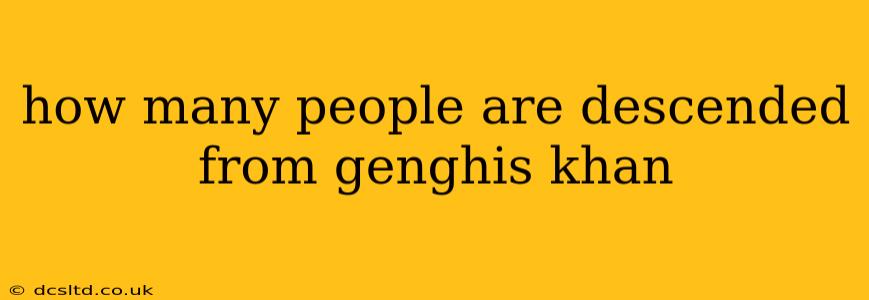The question of how many people are descended from Genghis Khan is a fascinating one, blending historical intrigue with modern-day genetic analysis. While a precise number is impossible to determine, the sheer scale of his impact on the gene pool is undeniable, making it a topic of ongoing scientific research and historical debate. This article will explore the evidence and the complexities of tracing such a vast lineage.
What Evidence Suggests Widespread Genghis Khan Descendants?
The most compelling evidence comes from Y-chromosome studies. The Y-chromosome, passed down virtually unchanged from father to son, allows scientists to trace paternal lineages. Remarkably, a specific Y-chromosome haplotype, or genetic marker, known as Star Cluster, is unusually prevalent across a vast region of Asia. This high frequency strongly suggests a common ancestor, and many researchers link it to Genghis Khan and his close male relatives. The sheer geographical spread of this haplotype is astonishing, covering a territory encompassing millions of people.
How Many People Share This Haplotype?
Estimates vary considerably, depending on the methodology and scope of the studies. Some research suggests that up to 16 million men might share this particular Y-chromosome lineage. However, it's crucial to remember that this doesn't necessarily mean these 16 million are direct descendants of Genghis Khan himself. The number includes descendants of his many sons, grandsons, and other close male relatives who also spread their genes widely. The vast Mongol Empire and its extensive network of conquest and trade facilitated this widespread dispersal.
Why Is It Difficult to Give an Exact Number?
Several factors complicate providing an exact figure:
- Genealogical Records: Reliable genealogical records from the time of Genghis Khan are scarce and often fragmented, hindering accurate tracing of lineages through history.
- Population Movement: Over centuries, populations have migrated, intermarried, and dispersed, making it challenging to track the lineage definitively.
- Genetic Drift: Random genetic events over generations can modify or obscure genetic markers, making tracing older lineages more challenging.
- Multiple Branches: Genghis Khan had many sons, each with numerous descendants. Tracing all branches to an accurate number is virtually impossible.
Are All Carriers of the Star Cluster Haplotype Direct Descendants?
No. While the high frequency of the Star Cluster haplotype strongly suggests a shared ancestry with Genghis Khan or his close male relatives, it's not definitive proof of direct descent from Genghis Khan himself. It implies a common ancestor within a specific timeframe and geographic location. The sheer number of descendants from many related males over several generations makes pinpointing individual lineages incredibly complex.
What Other Factors Contribute to the High Frequency of the Haplotype?
Beyond the potential link to Genghis Khan, other factors could contribute to the frequency of the Star Cluster haplotype. These factors include population bottlenecks, founder effects, and random genetic drift that might have concentrated specific genetic markers in certain areas.
Conclusion: A Remarkable Genetic Legacy
While a precise number of Genghis Khan's descendants remains elusive, the research strongly indicates a significant and widespread genetic legacy. The prevalence of the Star Cluster haplotype underscores his immense historical influence, not only on world events but also on the genetic makeup of millions of people across Asia. The ongoing research continues to refine our understanding of this fascinating phenomenon.
